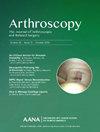Machine-Learning Models Reliably Predict Clinical Outcomes in Medial Patellofemoral Ligament Reconstruction
IF 5.4
1区 医学
Q1 ORTHOPEDICS
Arthroscopy-The Journal of Arthroscopic and Related Surgery
Pub Date : 2024-08-10
DOI:10.1016/j.arthro.2024.07.028
引用次数: 0
Abstract
Purpose
To develop a machine-learning model to predict clinical outcomes after medial patellofemoral ligament reconstruction (MPFLR) and identify the important predictive indicators.
Methods
This study included patients who underwent MPFLR from January 2018 to December 2022. The exclusion criteria were as follows: (1) concurrent bony procedures, (2) history of other knee surgeries, and (3) follow-up period of less than 12 months. Forty-two predictive models were constructed for 7 clinical outcomes (failure to achieve minimum clinically important difference of clinical scores, return to preinjury sports, pivoting sports, and recurrent instability) using 6 machine-learning algorithms (random forest, logistic regression, support vector machine, decision tree, implemented multilayer perceptron, and K-nearest neighbor). The performance of the model was evaluated using metrics such as the area under the receiver operating characteristic curve, accuracy, specificity, and sensitivity. In addition, SHapley Additive exPlanation summary plot was employed to identify the important predictive factors of the best-performing model.
Results
A total of 218 patients met criteria. For the best-performing models in predicting failure to achieve the minimum clinically important difference for Lysholm, International Knee Documentation Committee, Kujala, and Tegner scores, the area under the receiver operating characteristic curves and accuracies were 0.884 (good) and 87.3%, 0.859 (good) and 86.2%, 0.969 (excellent) and 97.0%, and 0.760 (fair) and 76.8%, respectively; 0.952 (excellent) and 95.2% for return to preinjury sports; 0.756 (fair) and 75.4% for return to pivoting sports; and 0.943 (excellent) and 94.9% for recurrent instability. Low preoperative Tegner score, shorter time to surgery, and absence of severe trochlear dysplasia were significant predictors for return to preinjury sports, whereas the absence of severe trochlear dysplasia and patellar alta were significant predictors for return to pivoting sports. Older age, female sex, and low preoperative Lysholm score were highly predictive of recurrent instability.
Conclusions
The predictive models developed using machine-learning algorithms can reliably forecast the clinical outcomes of MPFLR, particularly demonstrating excellent performance in predicting recurrent instability.
Level of Evidence
Level III, case-control study.
机器学习模型能可靠预测髌股内侧韧带重建术的临床效果。
目的:开发预测 MPFLR 后临床结果的机器学习模型,并确定重要的预测指标:本研究纳入了 2018 年 1 月至 2022 年 12 月期间接受 MPFLR 的患者。排除标准如下:1)同时接受骨性手术;2)有其他膝关节手术史;3)随访时间少于 12 个月。采用六种机器学习算法(随机森林算法、逻辑回归算法、支持向量机算法、决策树算法、多层感知器算法和 K 最近邻算法),针对七种临床结果(未能达到临床评分的 MCID、恢复到受伤前的运动状态、枢轴运动和复发性不稳定性)构建了 42 个预测模型。该模型的性能使用接收者工作特征曲线下面积(AUC)、准确性、特异性和灵敏度等指标进行评估。此外,还采用了夏普利加性解释汇总图来确定表现最佳模型的重要预测因素:结果:共有 218 名患者符合标准。在预测 Lysholm、IKDC、Kujala 和 Tegner 评分未能达到 MCID 的最佳表现模型中,AUC 和准确率分别为 0.884(良好)和 87.3%、0.859(良好)和 86.2%、0.969(优秀)和 97.0%、0.760(尚可)和 76.8%;恢复受伤前运动的准确度分别为 0.952(优秀)和 95.2%;恢复枢轴运动的准确度分别为 0.756(尚可)和 75.4%;复发性不稳定的准确度分别为 0.943(优秀)和 94.9%。术前Tegner评分较低、手术时间较短以及无严重套骨发育不良是恢复受伤前运动的重要预测因素,而无严重套骨发育不良和髌骨alta则是恢复枢轴运动的重要预测因素。年龄较大、性别为女性、术前Lysholm评分较低是复发性不稳定的重要预测因素:结论:使用机器学习算法开发的预测模型可以可靠地预测 MPFLR 的临床结果,尤其是在预测复发性不稳定性方面表现出色:证据级别:III级,病例对照研究。
本文章由计算机程序翻译,如有差异,请以英文原文为准。
求助全文
约1分钟内获得全文
求助全文
来源期刊
CiteScore
9.30
自引率
17.00%
发文量
555
审稿时长
58 days
期刊介绍:
Nowhere is minimally invasive surgery explained better than in Arthroscopy, the leading peer-reviewed journal in the field. Every issue enables you to put into perspective the usefulness of the various emerging arthroscopic techniques. The advantages and disadvantages of these methods -- along with their applications in various situations -- are discussed in relation to their efficiency, efficacy and cost benefit. As a special incentive, paid subscribers also receive access to the journal expanded website.

 求助内容:
求助内容: 应助结果提醒方式:
应助结果提醒方式:


